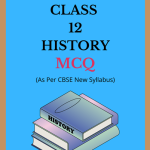NCERT Class 12 History MCQ Chapter 5 Through The Eyes of Travellers Perceptions of Society Solutions to each chapter is provided in the list so that you can easily browse through different chapters NCERT Class 12 History MCQ Chapter 5 Through The Eyes of Travellers Perceptions of Society and select need one. NCERT Class 12 History MCQ Chapter 5 Through The Eyes of Travellers Perceptions of Society Question Answers Download PDF. NCERT History MCQ Class 12 Solutions.
NCERT Class 12 History MCQ Chapter 5 Through The Eyes of Travellers Perceptions of Society
Also, you can read the NCERT book online in these sections Solutions by Expert Teachers as per Central Board of Secondary Education (CBSE) Book guidelines. CBSE Class 12 History MCQ Solutions are part of All Subject Solutions. Here we have given NCERT Class 12 History MCQ Part – I: Themes in Indian History, History MCQ Part – II: Themes in Indian History, History MCQ Part – III: Themes in Indian History. NCERT Class 12 History MCQ Chapter 5 Through The Eyes of Travellers Perceptions of Society Notes, NCERT Class 12 History MCQ Notes for All Chapters, You can practice these here.
Through The Eyes of Travellers Perceptions of Society
Chapter: 5
| THEMES IN INDIAN HISTORY (PART – II) |
| MCQ |
1. Which is correctly matched:
(a) Muhammad Ibn Ahmad Abu Raihan Al Biruni was originally from Khwarism.
(b) Macro Polo came from Spain.
(c) Ibn-Battuta came to India from Morroco.
(d) Antonio Monserrate came from Italy.
Ans: (c) Ibn-Battuta came to India from Morroco.
2. Match the following:
| I | II |
| 1. Peter Mundy. | (i) Morroco. |
| 2. J. Baptise Tavernier. | (ii) England. |
| 3. Antonio Monserrate. | (iii) France. |
| 4. Ibn-Battuta. | (iv) Spain. |
Options:
(a) 1.-(i), 2.-(ii), 3.-(iii), 4.-(iv)
(b) 1.-(ii), 2.-(i), 3.-(iv), 4.-(iii)
(c) 1.-(iv), 2.-(iii), 3.-(ii), 4.-(i)
(d) 1.-(ii), 2.-(iii), 3.-(iv), 4.-(i)
Ans: (d) 1.-(ii), 2.-(iii), 3.-(iv), 4.-(i)
3. The accounts of Al-Biruni are called:
(a) Kitab-ul-Hind.
(b) Rihala.
(c) Tujuk-i-Babri.
(d) Ain-i-Akbri.
Ans: (a) Kitab-ul-Hind.
4. Ibn Battuta book of travel is called:
(a) Rihla.
(b) Kitab-ul-Hind.
(c) Akbarnama.
(d) Tarikha Firsh Shai.
Ans: (a) Rihla.
5. Historians have expressed different opinions on the invasion of Mahmud. Which is the most accepted opinion?
(a) The aim of Mahmud was to end the rule of Hindu rulers.
(b) He wanted to extend his empire in India.
(c) His aim was to loot and plunder India And to enrich his own kingdom.
(d) He desired to accept Indian culture.
Ans: (c) His aim was to loot and plunder India And to enrich his own kingdom.
6. Who was the Arabian traveller to write that with the death of the king, the queens were burnt as Sati?
(a) Suleiman.
(b) Abu Mashr.
(c) Al-Idrisi.
(d) Abu-Bakr.
Ans: (a) Suleiman.
7. Who founded Delhi as a city full of exciting opportunities?
(a) Ibn-Battuta.
(b) Al-Biruni.
(c) Francois Bernier.
(d) Karl Marx.
Ans: (a) Ibn-Battuta.
8. Choose the correct option:
(a) Ibn-Battuta travelled extensively in China.
(b) Al-Biruni found the Indian cities quite populated.
(c) Al-Biruni was greatly influenced by the Indian postal system.
(d) According to Ibn-Battuta. crown ownership of land was quite disastrous for farmers.
Ans: (d) According to Ibn-Battuta. crown ownership of land was quite disastrous for farmers.
9. Consider the following statements.
1. Montesquieu used Bernier’s accounts to develop his idea of oriental despotism.
2. Bernier gave a detailed report on rural society.
3. According to Bernier, crown ownership of land was good for peasants.
4. Bernier onsidered Indian King was the king of beggars.
Which of the given statement is/are correct?
(a) 1, 2, 3, 4.
(b) 1, 2, 3
(c) 1, 2, 4.
(d) 2, 3, 4.
Ans: (c) 1, 2, 4.
10. Consider the following:
| 1. Al-Biruni. | (i) Rihla. |
| 2. Ibn-Battuta. | (ii) Kitab-ul-Hind. |
| 3. Francois Bernier. | (iii) Travels in Mughal Empire. |
Correctly match them:
(a) 1.-(ii), 2.-(i), 3.-(iii)
(b) 1.-(i), 2.-(ii), 3.-(iii)
(c) 1-(iii), 2.-(i), 3.-(iii)
(d) 1.-(ii), 2.-(iii), 3.-(i)
Ans: (a) 1.-(ii), 2.-(i), 3.-(iii)
11. The jeweller who travelled to India many times was:
(a) Duarte Barbosa.
(b) Roberto Nobili.
(c) Jean-Baptiste Tavernier.
(d) François Bernier.
Ans: (c) Jean-Baptiste Tavernier.
12. According to Ibn Battuta’s account the city that rivalled Delhi was:
(a) Multan.
(b) Gwalior.
(c) Lahore.
(d) Daulatabad.
Ans: (d) Daulatabad.
13. The merchant community in western India was known as:
(a) Dola.
(b) Wakil.
(c) Mahajans.
(d) Sheth.
Ans: (c) Mahajans.
14. The oldest son of Shah Jahan was:
(a) Dara Shukoh.
(b) Aurangzeb.
(c) Shah Shuja.
(d) Murad.
Ans: (a) Dara Shukoh.
15. The chief of the merchant community, in urban centers, was known as:
(a) Nagarseth.
(b) Mahajans.
(c) Mullas.
(d) Vaids.
Ans: (a) Nagarseth.

Hi! my Name is Parimal Roy. I have completed my Bachelor’s degree in Philosophy (B.A.) from Silapathar General College. Currently, I am working as an HR Manager at Dev Library. It is a website that provides study materials for students from Class 3 to 12, including SCERT and NCERT notes. It also offers resources for BA, B.Com, B.Sc, and Computer Science, along with postgraduate notes. Besides study materials, the website has novels, eBooks, health and finance articles, biographies, quotes, and more.




